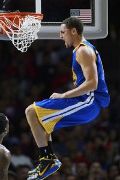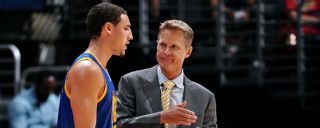|
At the Golden State Warriors' practice facility, coach Steve Kerr said something that had merit but little statistical basis: “Klay [Thompson] is at the point of his career where he’s very close to being an All-Star.” Kerr is not a stupid person, and he’s not exactly prone to happy hyperbole either. One jarring difference from last season is this coach’s candor in discussing shortcomings. You hear terms like “bad practice,” confessions of broken plays, admissions of vulnerability that the previous coach felt too assailed to reveal. While the last guy made basketball seem like a war conquered by confidence, the current one makes it sound like an all-obsessing job, fraught with fallibility. So how can the Warriors' coach believe that a player who has never notched an above-league average PER stands on the cusp of stardom? How can Kerr be so confident in Thompson when his shooting guard lags in so many categories outside of points?  A lot of it rests on the idea that Thompson can quite literally choose to be a much better player. As in, he can take more of the shots he’s incredible at, and fewer of the shots that give little reward. The way Kerr put it after the “All-Star” assessment: “What I talk to him about is getting greedy, but not with bad shots. Getting greedy with good shots.” A lot of it rests on the idea that Thompson can quite literally choose to be a much better player. As in, he can take more of the shots he’s incredible at, and fewer of the shots that give little reward. The way Kerr put it after the “All-Star” assessment: “What I talk to him about is getting greedy, but not with bad shots. Getting greedy with good shots.”
Getting greedy with good shots. That painted arc is the line between a bad kind and good kind of selfish. Kerr continued, “He can shoot 25-footers with ease. The floor is his, but he’s got to be efficient and smart with the way he uses it.” Thompson should be one of the league’s most efficient scorers, thanks to a high-release distance jumper that’s equal parts accurate and unblockable. His scoring efficiency was, like last season’s Warriors offense, disappointingly average. Both Thompson and the Warriors were hyped as offensive juggernauts throughout the year. Both Thompson and the Warriors squandered advantages by relying too much on midrange post-ups. Golden State finished last in the league in passes per possession. Thompson finished last in the league in passes per touch. Stephen Curry is the superstar and face of the franchise, but at the moment his backcourt partner better symbolizes where the organization is at: its potential, its improved defense, its flaws, its uncertain future. The Warriors are deliberating over Thompson’s second contract, and he’s the player who must improve for them to compete for titles. It’s difficult to envision Golden State as a contender if Curry remains the lone star. The hope is that Kerr unlocks Thompson’s and this team’s promise with an offense that moves the ball in a manner Golden State hasn’t moved it. All the way from the practice court, through a window, you can see that the walls of Kerr’s office are slathered in dry-erase ink. The wall scribblings conjure something between intricate planning and madness. Prying eyes can’t clock just what the mysterious cave paintings mean. “What’s he building in there?” the part of your brain that sounds like Tom Waits might mutter. If what we’ve seen and heard is to be believed, he’s building an offense that incorporates elements of Spurs motion and elements of the triangle. With the assistance of former Phoenix head coach Alvin Gentry, there’s influence from the Nash-era Suns as well. The challenge for Golden State is to generate offense without floor-spreading bigs like so many teams have -- like what the Warriors would have had if they’d traded for a certain current Cleveland Cavalier. For Golden State to live up to its billing as some revolutionary, exciting “Splash Brothers” attack, it must thrive with a positively old-school look. The Warriors must score with a center and power forward passing out of the post. Kerr is sanguine about the possibilities, though. When asked if it’s a challenge to lean on passing (as opposed to shooting) bigs, Kerr exclaimed, “It would be a challenge to not have those guys!" He chuckled, then added, "When you have great passing bigs, it makes offense so much easier. Two things can really stretch the floor: shooting and passing. If you have good interior passing, you can get the spacing that you need.” Many teams stretch the floor with the mere presence of shooters. The Warriors hope to stretch defenses with their decisions. It’s not as simple as just rolling the ball out and hoping Andrew Bogut and David Lee pass incisively, though. The team must move in a way that primes the passing. Kerr explained the general idea behind the new offense as, “You take whatever talent you have. What we have is a great shooting backcourt and excellent passing bigs, so that’s why you see us doing what we’re doing. A lot of dribble handoffs, a lot of moving and cutting, because we know we have the skill to move the ball around.” The dribble handoffs have been a distinct feature of an offense that came firing out of the gate this preseason. Bogut, thought by many to be a defense-only player, operates as the fulcrum of so much offense. He doesn’t simply set screens. He confrontationally dribbles the ball directly at smaller defenders, halts and blocks their path to Curry or Thompson. Bogut explains, “If I can attack first and then get a better [passing] angle, it creates so much havoc for that big guy guarding me because he has to show on guys like Steph.” Teammates orbit Bogut as defenders desperately try to get around his wide, jutted body. Defenders who doggedly chase Curry or Thompson around the screen can often be evaded with a cut away from the pick. If this happens, Bogut is more than likely to hit the open man with a crisp pass. If he still has his dribble, you might be treated to the comedy of a fake handoff that tricks everybody, followed by a slow turn and stroll through a vacant paint. It’s a shocking sight, like if the Arc de Triomphe grew sick of the circling traffic, uprooted itself and strolled down the Champs-Elysees past gawking tourists. Bogut has averaged 7.25 assists per 40 minutes this preseason, and it would appear he’s enjoying a system where, “They obviously want me to be involved more, especially the high post area to utilize my passing.” The ever-wary vet finished that thought with, “I’m not going to say, ‘I hated last year.’ I loved last year. I’m at a point in my career where I play whatever role coach wants me to, and if they want me to handle the ball more, I’ll do that.” Like a few of his teammates, Bogut is careful to stop short of slighting the old regime. Lee has also thrived in the dizzying circles this preseason, frequently cutting behind the action for points at the rim. He’s claimed a 27.02 PER, and against Miami, he hit all 11 of his shots. Like with Bogut, Lee’s expected to export offensive creativity from inside the arc. In last season’s stilted system, Lee posted his lowest assist average since he was a reserve with the Knicks, back in 2008. More movement might mean more opportunities for Lee to tap into his skill set. The two Warriors bigs, guys who don’t appear on “Splash Brothers” posters, are subtly linked to Thompson’s story arc. With the burden of creativity shifting from Thompson (and his post-ups) to Bogut and Lee, the thinking is that the shooter will get better shots. So far it’s working spectacularly, at least in this preseason. Thompson’s claimed a ridiculous 34.86 PER while driving more and posting less. In the background, his agent negotiates his lucrative contract extension with Warriors GM Bob Myers. While the Warriors don’t expect Thompson to average over 34 points per 40 minutes (as he’s doing this preseason), they do expect him to validate the faith that’s implied in the rejection of a Kevin Love trade. Both sides want a deal, though this is complicated by the dizzying array of possibilities created by the NBA’s new TV contract. In theory, Thompson’s long-term Warriors commitment is only a matter of time. As for Thompson making an All-Star team, that could be more a matter of strategy.
|

